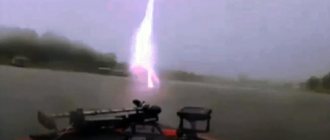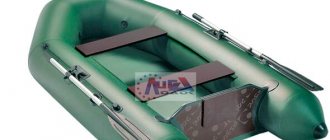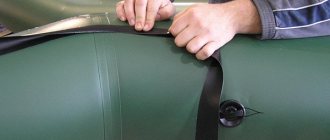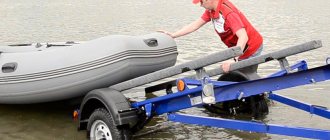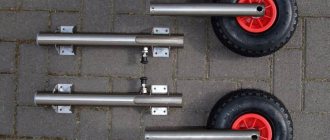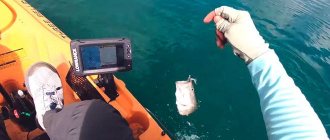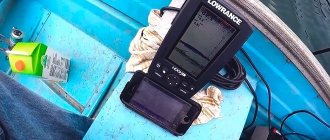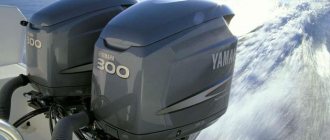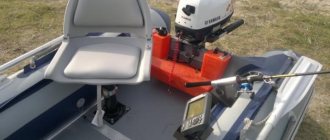There was a time when roads had not yet been built through dense forests and wetlands. The only way along which goods could be transported or troops could be deployed to meet the adversary was rivers.
Remember the battles of antiquity: “Battle of the Kalka River”, “Battle of the Neva”, “Battle of the Ice”, “Standing on the Ugra River”... The list can be continued independently. And the word “Rus” comes from the word “channel”, which again and again reminds us of the close connection of the inhabitants of our lands with the waterways of our lands - rivers. Yes, many cities grew up along the banks of rivers and not only in Rus'. Naturally, it would be strange if residents of cities and villages located along the banks of rivers did not eat fish.
Archaeologists, in any case, claim that fish was one of the main products in those distant years. However, it is difficult for us to imagine how people lived in those distant years. It is difficult to understand how merchants transported goods along rivers from distant Scandinavia to the equally distant and mysterious Tsar Grad. It is difficult to imagine how the squads of various princes came together in a boarding battle. But without swimming facilities it is impossible to imagine life in Rus'.
It is even more difficult to imagine how ancient fishermen managed without boats. And you don’t need to imagine this, because fishing without a boat in those days was a dangerous and quite difficult activity.
boat
And in our times, all this is quite relevant. There are many bodies of water where fishing from the shore is very difficult or even impossible. For example, lakes overgrown with reeds, where normal casting and landing of fish is impossible. In many places, the fish stay away from the shoreline, which prevents normal, accurate casting even with match gear.
There are reservoirs where a thick layer of silt at the bottom makes it impossible to use donkey for fishing.
There is only one way out - to go to the outer border of aquatic vegetation on some kind of floating device. The boat was considered the best at all times.
Since ancient times, boats have been made from a variety of materials. The very first material from which boats were made was reed, then the boats were hollowed out of wood and made from the skins of various animals.
Some time passed and wooden planks became the main material for making boats.
As time passed, the design of some boats began to use cylinders into which air was pumped under pressure. Inflatable boats appeared, which revolutionized the creation of compact fishing boats.
However, progress came in different ways. The time has come, and the industry has mastered the production of light metal boats, such as the Kazanka, which were quite difficult to transport, but they were durable and reliable on the water.
Further development of technology led to the creation of boats made of polymer materials. The first, of course, were boats made of plastic, then boats made of composite materials.
Gradually, such boats became more convenient for fishermen, taking into account specific fishing conditions.
Today, all boats that can be used for fishing can be classified according to several criteria. The main one is the material from which the boat is made.
Wooden boats
These are the traditional means of moving a fisherman around a body of water. The technologies for producing these products have not changed for centuries.
It is unlikely that an enterprise has survived in nature that
produces such boats industrially.
wooden boat
They are built by local craftsmen. They are built for fishing in a specific body of water. Each body of water has its own traditions of such construction. A wooden boat is launched into the water in a certain place and removed from the water only in the fall or, as a last resort, in case of damage to the craft.
City fishermen, if they do not live on the banks of a river or lake, are little familiar with the features of these predominantly rowing vessels. And in rural areas such a boat is still a completely common attribute of an avid fisherman.
Boats
A boat is a type of transport designed for human use in areas with open bodies of water, such as lakes and rivers. Such vessels are distinguished from a large ship by their smaller size, general appearance, spaciousness and carrying capacity. However, the purpose of the boat, and in particular its size, appearance, and even shape, can vary depending on its goals set for the vessel.
Historical evidence suggests that such a vehicle has been used to travel on water since ancient times. From the oldest known boat, a photo of which survives to this day, technological advances in water transport have reached impressive cruise ships.
Apart from entertainment, boats also serve functions in the current world of commerce. With their help, they transport not only passengers, but also cargo.
Inflatable boat
For quite a long time, ordinary rubberized fabric was used to make fishing boats.
Everything has changed since PVC fabrics appeared. A boat made of this material has become much stronger and lighter. From a purely rowing small vessel, it began to turn into a watercraft quite suitable for installing a motor.
PVC inflatable boat
Gradually, such boats were appreciated not only by fishermen, but also by hunters, therefore today an inflatable boat cannot be considered an invention designed for use exclusively by fishermen. Such boats are also widely used by the military and rescuers.
Boat classification
Currently, boats are used not only as transport, but also as recreational and sports vehicles. The classification of boats is always controversial and has no clear boundaries. Typically, modern models are classified according to the type of body material: plywood, metal, plastic, inflatable. The second section of the classification of boats is their purpose: pleasure, cargo, fishing, sports, passenger, hunting. Boats can also be divided by hull type: monoblock, catamarans, trimarans. The type of bottom affects seaworthiness: flat-bottomed, keeled, combined (complex). Based on the availability of propulsion, boats are classified into rowing, motor, and sailing. When choosing water transport for certain needs, the question of dimensions arises: large ones have better seaworthiness and consumer properties, small ones are convenient for transportation and storage. Boats can be collapsible or foldable. There is no single generally accepted classification of boats and everyone makes their choice based on completely different criteria. At the same time, boat manufacturers try to classify their products themselves and position them as the most suitable for a particular need. The shape and layout of boats are constantly changing, acquiring more convenient features and becoming more maneuverable, safe and reliable. But when choosing a vessel, you need to understand that any boat is a compromise between stability, controllability, speed, reliability and other factors.
PVC inflatable boats have many advantages over other small fishing vessels:
1. This boat is compact. Some single-seat models can fit into a medium-sized backpack.
2. The boat weighs quite little. An inflatable boat, when folded and equipped, can be moved along the shore and in the water by one person.
3. The inflatable boat can be used in shallow water conditions.
4. It is extremely stable. You can turn such a boat over on the water only by applying maximum effort. Even on the rapids she feels quite comfortable.
This boat also has disadvantages:
1. Level of comfort. Still, it is quite difficult to sit comfortably in an inflatable boat;
2. The boat handles quite poorly, especially compared to its metal sisters;
3. To propel such a boat, a more powerful engine will be required compared to a metal boat.
Boats with false bottom
A special model of inflatable vessels are boats with an overhead bottom (RIB-boats). They combine the buoyancy of inflatable vessels and the rigidity of modern boats. The keel of such boats is durable, made of fiberglass, polyethylene or aluminum, and the pipes are flexible.
RIB boats come in a variety of types and parameters. Many of them have control rooms (stands) and, moreover, have water-jet engines. These vessels are designed for your comfort. They have fuel tanks, seats, drawers and even a shower - that’s not all that such an assistant can please you with.
Inflatable boats can be:
1. Rowing. The boats have a very simple and reliable design. The inflatable boards are divided into several separate sectors. This design, even if one of them is damaged, allows the boat to remain afloat. The bottom of such a boat can be made of ordinary rubber, or it can be reinforced with inserts made of plywood or plastic.
2. Motor. These boats feature a durable transom on which the engine is mounted. The sides of such a boat are more rigid. The bottom (payol) is usually either inflatable or reinforced with additional transverse “bars”. The more powerful the outboard engine will be used, the stronger the boat's structure will need to be.
3. A separate subcategory of inflatable boats Rigid Inflatable Boats (RIBs). These are outboard-powered boats that are designed to move very quickly through the water. The design feature of such a boat is a v-shaped floor.
This design allows the boat to reach speeds on the water of up to 100 km/h.
When planning to buy an inflatable boat, you need to remember that if you plan to use it exclusively for fishing, you do not need to opt for a large model. If you prefer to fish alone, then a boat up to 2.5 meters long will suit you.
If you like to fish in company, then it is better to choose a model with a length of at least 3.5 meters. A boat of this length is considered the most stable on the water. Yes, and there is more comfort in it.
For trolling and spinning, it is also recommended to use boats about 4 - 4.5 meters long.
Inflatable boats are most often made from durable fabric, which is covered with rubber, PVC with various additives.
PVC is considered a more durable material that perfectly resists the effects of solar ultraviolet radiation, does not rot or rot, and can withstand both low and high temperatures. Among other things, PVC is resistant to petroleum products.
The only disadvantage of PVC boats is that for some reason this material attracts the attention of rodents, which often damage the coating of the boat.
PVC inflatable boats are, of course, lighter than rubber ones, but they are more expensive. Therefore, if you are not going to fish in large bodies of water, then you can easily buy a boat made of rubber.
What types of boats, boats and yachts are there: types and their differences
Types and types of yachts
The type of yacht is determined by the type of engine. Sailing yachts move with the help of the wind, motor yachts with the help of an engine with horsepower. According to modern safety rules, today all sailing ships, including sports ones, are equipped with an emergency engine. But on motor boats, the installation of sails is not provided. But there is another variety: motor-sailing and motor-sailing yachts. In the first version, the main propulsion is the sail, and in the second - the motor, and the sail is only a decorative element.
Today, the yacht building industry is developing rapidly. Designers will improve existing models and create completely new types. Thus, double-hulled vessels are gaining popularity; they are also called catamarans. Even three-hulled yachts - trimarans - appeared. Of particular interest is the new product of the season - the “wave breaker”. This is a completely new design, which on top is a single-hull yacht, and on the bottom has two side floats (video), like a catamaran. Of course, this model has many advantages, but time will tell whether it will take root in yachting.
Sailing yachts
Sailing yachts are the most attractive and suitable for both sea trips and sports competitions. They can be cruising, racing or mixed. Cruising ships provide the opportunity to have a wonderful rest in comfortable cabins and have everything necessary for tourists to stay and make multi-day sea voyages.
Racing yachts
Racing yachts do not have cabins at all; they have nothing extra that would prevent them from increasing speed. Such yachts participate in short races and only have a cockpit for the crew. Race-cruising ones are equipped with unpretentious cabins, which contain only the essentials for the crew. The crew has to live on such yachts from several days to several months, depending on the duration of the sailing regattas.
Cruising Yats
Cruising yachts are the most in demand today. An increasing number of tourists want to experience the thrill, see the distant seas, and admire coastal and island views from the decks of comfortable yachts. There is all the necessary equipment to support the life of the vessel and create comfort for travelers. Such vessels are equipped with refrigeration and ventilation systems, have an elegant interior, and are equipped with recreation and swimming areas on the open sea. Their spacious premises make it possible to create additional reserves of water, food, and fuel.
Motor yachts
Motor yachts are more comfortable for sea travel, especially in light gusts of wind. They can reach speeds of up to 14 knots. Tourists feel especially good on such yachts when anchored. These vessels are designed for inter-island passages, for traveling from bay to bay, for leisurely walks through the most beautiful places on the planet. However, these trips cannot be long, since with strong gusts of wind and large waves, movement becomes uncomfortable and even dangerous. Such vessels do not have a long keel, so during a storm the yacht shakes violently. But in calm weather, a boat trip will give you an unforgettable experience.
Keelboats, Dinghys and compromises
To ensure the stability of the yacht, various methods are used. Depending on this, yachts are divided into keelboats, dinghies and compromises. In keel yachts, the bottom smoothly transitions into a ballast keel, which is called a false keel. It allows you to shift the center of gravity down and protects the ship from drifting under sails. There are also yachts with a retractable keel (photo). The dinghies have a retractable keel - a centerboard that prevents drift, and a change in the center of gravity is achieved by moving the crew along the sides.
Compromise options are equipped with both a false keel and a retractable centerboard. Modern comfortable cruising yachts also have dinghies, which allows, if necessary, to raise the centerboard completely and moor to the shore. There are also models with two centerboards, which makes it possible to maintain the vertical position of the yacht even at low tide in shallow water. Single-masted yachts are called sloops, multi-masted yachts are called schooners, they have a variety of sailing equipment.
By number of buildings
Based on the number of hulls, yachts are divided into single-hulls, double-hulls - catamarans, as well as three-hulls - trimarans and even multi-hulls - polymarans. Sailing catamarans are very popular. They are very comfortable, they almost never cause motion sickness, since two separate bodies are fastened together and do not allow them to sway to the sides. The superstructure that connects them is usually a huge company cabin where you can relax comfortably while admiring the beautiful sea views.
Vessel exterior
Based on the exterior of the vessel, yachts can be very diverse. But the most popular are classic designs. Design from the 19th century is still considered the standard of beauty today. The ideal combination of shape and filling of the yacht with everything necessary makes it the most fashionable, regardless of time and place. Modern designers repeat classic forms, adding something of their own to each, something that is suggested by personal imagination and technological progress.
In addition to the exterior and hull of the yacht, its navigation autonomy is important. It is determined by the time spent at sea in autonomous mode. Autonomy affects the cruising range and distance of the vessel from the shore. Of course, when choosing a yacht, you must first take into account its autonomy, because the material costs during its construction will depend on this, which significantly affects the final price.
Autonomy directly depends on fuel reserves. If the ship is equipped with heavy-duty engines, they will require a significant supply of fuel. And this requires additional tanks, which significantly increases the weight of the yacht, which means even more powerful engines will be required. This creates a vicious circle. So, with the large dimensions of the yacht, it is not always possible to go considerable distances. The emergency fuel reserve should be 5-10%. Therefore, the best option is to move no more than 100 miles from the base. This is quite enough to make an exciting trip to the sea on a yacht.
The difference between a yacht, a boat and a boat
Previously, it was believed that if a vessel has an outboard motor, then it is a motor boat, if it is stationary, then it is a boat, and if it is sailing, then it is a yacht. Just like sex, there were no motor yachts in the Soviet Union. When we see a 6-8 meter vessel on the water, with twin engines of 300 horsepower, and with all the delights of life, we cannot dare to call this miracle a “boat”. The same thing with 18-meter three-deck “boats”. You will never make a mistake if you distinguish them by several signs.
- A vessel up to 2 meters long is a small boat. You can safely operate such a vessel after completing a 3-day training course. A motor boat is a small boat with an outboard motor and is considered a budget option. A motor boat is perfect for fishing. You can also take a boat with friends to the island.
- A vessel with a stationary motor is called a boat. The traditional length of the boat is 5-10 meters. There are different boats, ranging from small fishing boats to high-speed racing cars.
- A vessel with increased comfort, 10 to 20 meters long, is called a yacht. Perfect for a summer holiday with friends and business partners. Also perfect for everyday life while traveling around the world.
Metal boats
Such boats have been produced and are currently being produced. Aluminum, duralumin and even steel were used as the main material at different times.
metal boat
Metal boats are durable, stable, and repairable. Most often, they normally transfer transportation to another body of water. But such boats also have disadvantages. The main thing that fishermen usually pay attention to is that they are quite noisy.
It is very difficult for an angler to navigate such a craft without creating excessive noise. And it’s quite difficult to fish on a wave from such a boat, because any impact of a wave on the side of the vessel causes a long-drawn roar, similar to the striking of a bell.
Gradually, changes are being made to the design of such boats, and the noise is gradually decreasing, but still...
Aluminum fishing boats belong to the class of small vessels. Initially, these boats were designed for travel (walking) along rivers, lakes and reservoirs in conditions where the wave height does not exceed 0.5 m, as well as with a wind force that does not exceed force 4.
Currently, boats of this type are already adapted for fishing. The design allows free movement from the control room to the engine along the side.
The advantages of boats made of this material include:
1. Increased compared to other boats
structural strength.
2. Level of comfort. Modern metal boats are quite comfortable.
3. Durability. Such boats do not need to be painted frequently to protect them from corrosion.
4. Weight. Boats made of this material can be pulled ashore quite easily.
5. High degree of buoyancy. This applies, first of all, to boats made of duralumin, the design of which uses hollow, air-filled tanks.
6. Volume. After all, such boats were originally designed to be used by 3-4 people. The space completely allows this to be done.
The disadvantages include the too high cost of repairs. Especially if you have to use argon welding, and another type of welding cannot be used in the repair of products made of aluminum or duralumin.
And such a boat is quite expensive, like any product made of metal compared to the same product made of plastic.
Boat registration rules
Rules for registering boats
According to the Federal Law of the Russian Federation of April 23, 2012 N 36-FZ “On amendments to certain legislative acts of the Russian Federation regarding the definition of the concept of a small vessel.” Small vessels include: catamarans, jet skis, kayaks, cutters, yachts, motor and rowing boats.
Registration is not subject to:
- inflatable non-motorized boats weighing up to 200 kilograms inclusive;
- motor boats weighing up to 200 kg and engine power up to 8 kW (10.88 hp) inclusive.
In 2014, obtaining rights for engines over 5 hp was cancelled. If the engine power of a small boat exceeds 8 kW (10.88 hp), you must have a certificate for the right to operate a small boat.
When purchasing a small boat, the owner is required to register it within 10 days from the date of purchase. It is worth noting that the GIMS pays attention to the power in kilowatts, which is indicated in the motor’s passport!
Required documents:
- documents for the vessel (sale and purchase agreement, gift or general power of attorney, sales receipt (invoice);
- technical passport for the vessel;
- technical passport for the motor (if any);
- registration application card;
- owner's identification card;
- a receipt for payment of the state fee for registration and issuance of a ship ticket.
Registration procedure
- It is necessary to bring the boat and motor for inspection to GIMS. The boat must be inflated for inspection.
- The inspector draws up an inspection report.
- The registration application along with copies of purchase documents are submitted to the inspector.
- After one to three weeks you receive a ship ticket.
- It is necessary to apply side numbers to the boat hull.
Plastic boats
The main material used for the production of plastic boats is polyester resin, which is impregnated and coated with a pre-prepared mold made from reinforcing threads.
plastic boats
Experts distinguish the following types of plastic boats:
- Open boats;
- Boats with a closed bow;
- Boats with cabins.
1. Open plastic boats can be used as rowing or motor boats. The maximum length of such boats is 8 meters, the minimum is 3 meters. Such boats are designed for fresh water fishing in reservoirs with weak currents and no currents at all.
2. Boats with a decked bow are more comfortable and are in great demand among anglers who practice fishing in large bodies of water. Most often, this type of boat is used as a motor vessel for fishing in large bodies of water and in sea fishing. A special feature of this type of boat is the ability to install two engines.
3. Boats with cabins are used exclusively for sea fishing.
The use of plastic in the manufacture of boats made it possible to immediately solve several problems faced by designers.
1. Plastic boats have become more durable compared to products made from other materials. Plastic is absolutely not subject to corrosion and rotting.
2. The hull of a plastic boat can be given almost any shape, and, therefore, given certain qualities.
3. Plastic boats are much cheaper than metal boats.
Disadvantages of this type of boat:
1. Relative fragility;
2. Short service life;
3. Difficulty of repair.
I would also like to mention the existence of homemade and industrial hybrid boats, one of the types of which we have already mentioned in the story about inflatable boats.
Rowing boats. Types and application. How to choose and features
The boat is one of the most ancient means of transport. It appeared much earlier than wheeled or skid transport. In ancient times, rowing boats were used as a means of transporting goods, fishing and other useful activities. Now they are used as pleasure and sports vessels.
Most boats are propelled by oars, but some are equipped with sails or motors as auxiliary or primary means of propulsion. On some vessels that do not have a motor by design, it is installed by users.
A little history
A boat is considered to be a waterfowl up to 9 meters long and up to 3 meters wide. The maximum carrying capacity of the boat is 5 tons. Initially, boats were only rowing vessels, but later they began to be equipped with sails, and in the 20th century, with motors.
Questions related to choosing a boat
Before purchasing an inflatable boat, you need to think carefully and ask yourself the following questions:
- Why are you buying a boat: fishing, duck hunting, tourism, diving.
- How many people will you take on the boat?
- What is its carrying capacity?
- Do you need sleeping places in the boat, a deckhouse, an awning, etc.?
- Is a motor required?
- Is a keel necessary?
- What speed are you planning to reach?
- What kind of fuel consumption are you prepared for?
- In what conditions and on what bodies of water are you going to swim?
The choice of a boat is based on the purposes of its use, and then evaluate all its other parameters, such as length, shape, material, transom, etc.
Main indicators of boats:
- Length;
- width;
- cylinder diameter;
- body shape;
- bottom type;
- presence of a keel;
- fabric density;
- number of seats;
- presence of transom;
- warranty period of service;
- number of hermetic compartments of the boat.
Technical characteristics of the boat Hunter 280 LT
From a wide range of all kinds of watercraft, we present to your attention the comfortable boat Hunter 280 LT. This boat is made of durable material - PVC, and even the most demanding fishermen and athletes will like it. This model is very comfortable and has all the necessary tools for successful fishing. At its low price, the boat includes the following things:
- Oars
- Pump
- Hard collapsible floor
- Seats
- Bow awning
- Hinged transom for motor
- Spinning rod holders
Boat with motor on suspended transom
If you don’t want to row with oars, then choose a PVC boat with a motor. It is worth keeping in mind that it is recommended to install an electric motor on a boat with a suspended transom. But many fishermen neglect this advice and install a gasoline engine on such boats.
If you are going to do the same, then you should take a closer look at a motor with a power of no more than 3 hp. Although even this power is too much, since the power of such an engine will press in the cylinder, and the propeller can crawl under the bottom. As a result, power will increase and speed will decrease, which is very inefficient. Such a motor must be tied to the boat!
For more powerful motors, inflatable boats with a built-in transom or .
Rating of the best PVC boat models of 2021
10HUNTERBOAT Hunter 320
The second place in our rating of the best PVC boats according to fishermen's reviews is occupied by a model from the Russian manufacturer HUNTERBOAT. Hunter 320 is a universal boat on which you can hunt, fish and spend a comfortable holiday with friends. This model can be used both with a motor and with oars.
In the manufacture of Hunter 320, durable German PVC fabric with a density of 750 g/sq.m was used. It protects well from stones and snags, which can easily get caught on while fishing. The manufacturer also did not forget to include useful little things in the package, such as an anchor eye and a repair kit. The maximum load capacity is 450 kg.
On paper it's a great option. In customer reviews (for example, on Yandex.Market) everything is less rosy, there are some complaints. Therefore, only 10th place.
pros
- Value for money
- Good capacity and load capacity
- You can install a motor up to 9.9 hp.
- Thick reinforced PVC fabric
Minuses
- Weak standard pump
- Difficult to install the floor
- Poor quality gluing of seams
9Lotsman S-260 M
This rowing boat has received many reviews on the Internet. It is very popular on the Russian market, and there is good reason for this. Its design, despite its low price, is quite reliable. The quality of the seams inspires confidence. The only thing I can complain about is that there is no hard or inflatable bottom. It is better not to overload the watercraft and use it for single swims.
The boat is very easy to inflate and deflate, but carrying it will be more difficult - the weight reaches 14 kilograms. Although this is nothing at all compared to the Pilot 330, where the weight of the set is 53 kg (although the motor, of course, is more powerful). In addition, the owners note that the weight of the S-260 M, considering its size, is quite “lifting”. Production material: reinforced PVC.
This option is suitable for an ordinary fisherman, but not for extreme sports or those who like to go out on the water in a large company. Small dimensions (260 cm length) are designed for moderate load.
pros
- High-quality tailoring
- Easy and quick to inflate
- Convenient pump, pumps in both directions
- Full oars
- Economy option
Minuses
- Not designed for heavy “load”, it’s cramped for two people
- Soft bottom
8Lotsman S-280 M
Like the youngest representative of the series (S-260 M), this inflatable boat boasts a relatively low weight (about 16 kg), absolute ease of use and sufficient comfort for one, maximum two people. The “face-groove” system allows you to adjust the position of the seats.
The bottom may seem thin to some, but the owners talk about its strength (although many, of course, would like an inflatable bottom). The manufacturer used dense five-layer PVC for the tension bottom to increase its service life.
As for this class and price segment, the boat has respectable dimensions - 280x140 cm, capable of supporting 220 kg of “live cargo”. Reviews note that the actual load capacity is higher than stated.
pros
- High quality PVC fabric
- Large diameter cylinders
- Quick assembly
- Economy option
Minuses
- Low motor power
7Admiral 320
Real owners of the Admiral 320 motor boat speak warmly about it and talk about good operating experience. High hydrodynamic characteristics are provided by cylinders with variable diameters, narrowed towards the nose, as well as well-thought-out body geometry. Compared to previous models in the series, the rigidity of the floorboards and the size of the cockpit have been increased.
Users note the external beauty of the craft, the high density of the material, which inspires confidence. The boat shows excellent maneuverability, easy access to an economical planing, even if there are two fishermen. Easy to assemble and disassemble, lightweight - 25 kg included.
The motor power is 10 hp, the number of seats is 4, and the rated load capacity is 450 kg. Not for extreme sports, but a suitable solution for the average fisherman and lover of water recreation.
pros
- Convenient rails and carrying handles
- Durability
- Built-in keel
- The “Lux” package includes a bow cover and a set of can covers
- Price-quality ratio
Minuses
- Possible “dancing with a tambourine” during assembly
6Mnev and K. Cayman N-330
There is a category of outdoor enthusiasts that divides inflatable boats into 2 categories - “Caymans” and all others. It really has a very good reputation in the Russian market, and the N-330 model is one of its successful representatives. It shows high seaworthiness (holds waves) and speed characteristics; fishermen and hunters note its increased reliability and long service life.
Of course, this is not the cheapest option. But the opportunities are corresponding. The engine produces a maximum power of 18 horsepower, and the strength of the bottom (non-inflatable) is designed for a maximum load capacity of 420 kg.
The total capacity is up to 4 people of normal build or up to 3 well-fed people. For maximum convenience, it is better to go sailing together.
pros
- Manufacturing quality and reliability
- Good speed data, maneuverability
- Built-in keel
- Built-in transom
Minuses
- Quite a large weight of the kit (more than 50 kg)
- Not the highest density of PVC - 850 g/m2
5HUNTERBOAT Hunter 420 PRO
An excellent boat for reasonable money, which is equipped with everything necessary for professional hunting and fishing. Due to its length of 420 cm, the Hunter 420 PRO can accommodate 6 passengers, and the vessel’s carrying capacity is a good 950 kg.
This model is designed for use in the harshest conditions. The boat is made of heavy-duty reinforced PVC. Low pressure inflatable bottom. Hunter 420 PRO can be used with a motor of up to 30 hp, but as experienced fishermen write, you can install a more powerful motor.
pros
- Durable material
- Not a bad price for this boat
- Large load capacity
Minuses
- The complete set weighs 60 kg
4REEF 360 OD
The small-sized PVC boat Reef is designed for different conditions: fishing, hunting, tourism, active recreation on different types of reservoirs. The model has a low-pressure inflatable bottom, which allows you to confidently move through shallow water, gain directional stability and shock absorption. This type of bottom reduces the time required to assemble and disassemble the boat.
Compared to the previous nominee in the rating, this one is smaller in size and weighs almost one and a half times less. At the same time, there was a slight loss in power - 25 hp. versus 30 hp, and capacity - 4.5/5.5 seats versus 6. There is a built-in transom, but there is no keel.
Reef inflatable boats are in good demand, as evidenced by the large range of models with a variety of sizes - from 290 to 450 cm in length.
pros
- Wide range of possibilities in small dimensions
- Large balloon
- Boat width - 182 cm, plenty of space
- Adequate cost
Minuses
- Weak pump
3Pilot Pilot M-330 Kiel
One of the best offers on the Russian market for its price. It will be a good purchase both for a beginner who is buying a boat for the first time, and for an experienced fisherman and hunter. The boat can be operated at different power levels, up to 15 hp, and high-quality reinforced PVC will create the necessary reliability and confidence in the craft.
A 60 mm wide beam, which reinforces the keel and bottom of the cylinders, protects the PVC from abrasion. Cylinders and keels tend to rub against the bottom and shore every time they moor, so this option is simply irreplaceable. Although many analogue models do not have it.
There is also additional PVC sizing in those places where the cylinder comes into contact with the stringers. It protects the PVC when the fabric rubs against the stringer and thus extends the life of the boat.
pros
- Clever design for max. reliability
- 4 body color options
- Reinforced 5-layer PVC fabric
- Good lateral stability
- Quick assembly
- Perfect reputation
Minuses
- Small dimensions and low load capacity (450 kg)
- Weak oar mounts
2Apache 3700
A premium model, which is sold in two versions: with an inflatable bottom and with a hard floor equipped with stringers. Boats with a hard floor handle better, have better habitability and are more convenient to transport, and NDND, in turn, offers higher speed (but not always), easier assembly and disassembly.
In its model range, the Apache 3700 is the largest and most spacious. The diameter of the cylinder is 48 cm - almost a record figure for this class, which ensures the stability and stability of the craft at speed and in static conditions. The SK modification provides increased controllability on the wave due to the increased rigidity of the prefabricated floor.
It is very comfortable to sit in the Apache boat, since the seat height is 39 cm. The model easily goes on planing, and the powerful motor allows you to easily overcome waves in adverse weather conditions.
pros
- Increased fabric density
- Long-term preservation of its original appearance
- High speed data
- Protection with PVC profile along the keel
- Enlarged cylinders
- Rich equipment (rails, handles, bag...)
Minuses
- High price
1Frigate M-430 FM Lux
Hardcore option for extreme sports fans. The motor boat can comfortably accommodate 6-8 passengers and confidently withstand a load of up to 900 kg. “Fregat” has absorbed all the best that the modern PVC boat market offers: high performance, safety and comfort.
The reliable multi-cylinder inflatable high-pressure bottom has the property of self-draining. The main cylinder received a large diameter, which increased the rigidity of the body. Better hydrodynamics and seaworthiness are ensured by a modified profile on the edges of the lower cylinders.
This option is recommended primarily for professionals and enthusiasts, for whom active recreation on the water is not just a way to while away free time, but rather a lifestyle. Scientific expeditions, tourism, extreme travel in any water area, rescue operations - for such tasks a boat of this level is indispensable.
pros
- 9 independent compartments
- Increased hull and bottom rigidity
- Bulwark + protective apron
- Optimized stall during planing
- Massive PVC protectors along the entire length of the bottom
- High engine power (up to 40 hp)
- Large boat width
Minuses
- High price
- Heavy weight - up to 83.4 kg
